Formation Mechanism and Gemological Characteristics of “Yellow-Skinned” Nanhong Agate in Northeastern Yunnan, China: Evidence from Mineralogy and Geochemistry
Abstract
1. Introduction
2. Geological Setting
2.1. Regional Geology
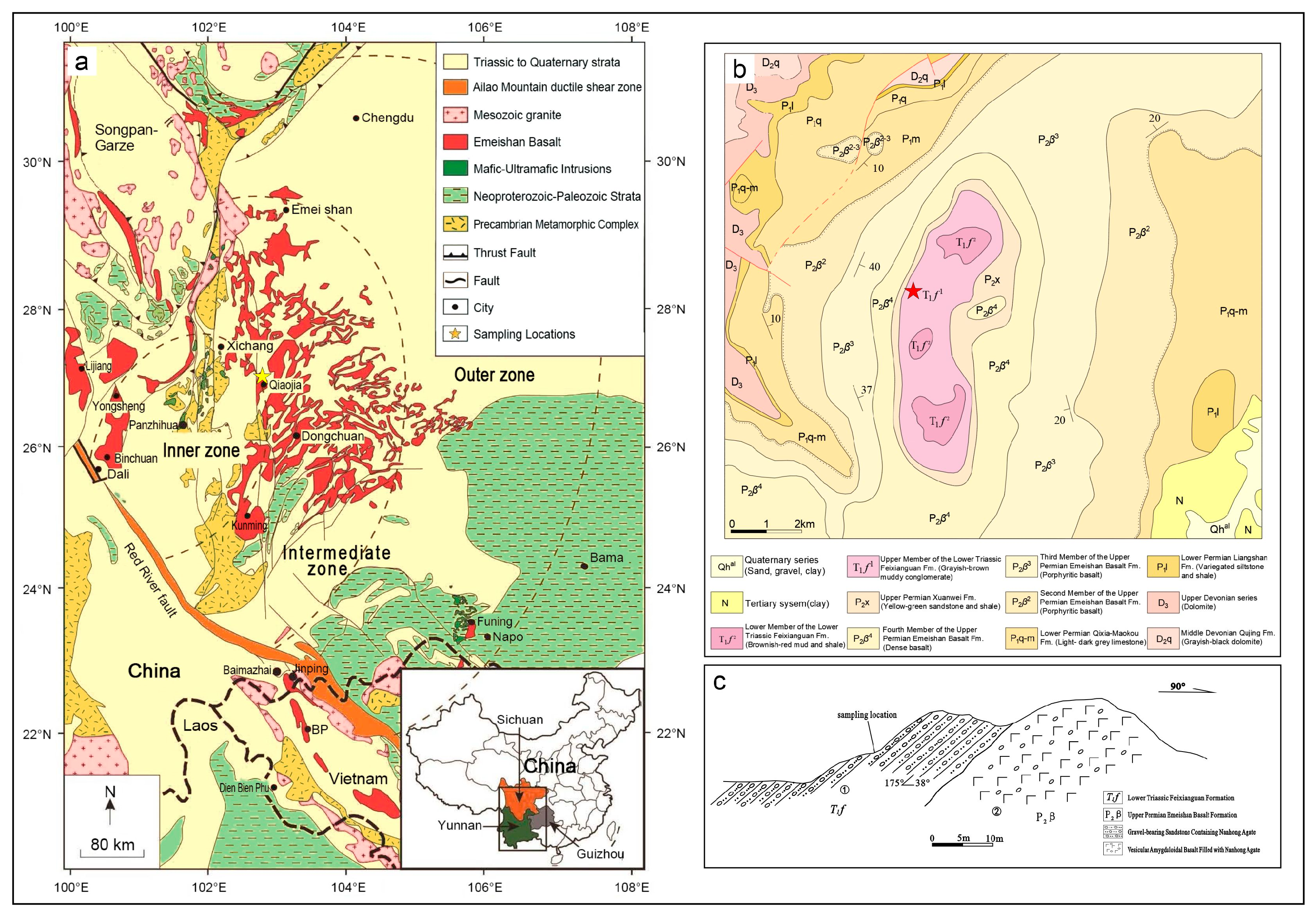
2.2. Deposit Geology
3. Materials and Methods
3.1. Sample Materials
3.2. Analytical Methods
4. Results
4.1. Basic Gemmological Characteristics
4.2. Microtextural Characteristics
4.3. Spectral Characteristics
4.4. Geochemical Characteristics
5. Discussion
5.1. Analysis of the Coloring Mechanism and Influencing Factors of the “Yellow-Skinned” Nanhong Agate
5.2. Crystallization Sequence
5.3. Characteristics of Occurrence and Formation of “Yellow-Skinned” Nanhong Agate
5.4. Age of the Nanhong Agate
6. Conclusions
Supplementary Materials
Author Contributions
Funding
Data Availability Statement
Acknowledgments
Conflicts of Interest
References
- Song, Q.Y.; Chen, L.R.X.; Zuo, R.H.; Chen, X.C.; Sui, S.G.; Pu, W.Z.; Yang, X.Q.; Zhang, S.T.; Liu, W.L. Origin of Color and Spectral Characteristics of Nanhong Agate from Northeast Yunnan, China. Crystals 2024, 14, 388. [Google Scholar] [CrossRef]
- Basibueyuek, Z.; Guerbuez, M.; Akbudak, I.K. Surprise Eggs, the Miracle of Nature: Almus Agates (Tokat-Turk?Ye). Gospod. Surowcami Miner.-Miner. Resour. Manag. 2023, 39, 5–22. [Google Scholar]
- Dumanska-Slowik, M.; Powolny, T.; Sikorska-Jaworowska, M.; Gawel, A.; Kogut, L.; Polonski, K. Characteristics and origin of agates from Ploczki Gorne (Lower Silesia, Poland): A combined microscopic, micro-Raman, and cathodoluminescence study. Spectrochim. Acta Part A-Mol. Biomol. Spectrosc. 2018, 192, 6–15. [Google Scholar] [CrossRef]
- Natkaniec-Nowak, L.; Dumanska-Slowik, M.; Prsek, J.; Lankosz, M.; Wróbel, P.; Gawel, A.; Kowalczyk, J.; Kocemba, J. Agates from Kerrouchen (The Atlas Mountains, Morocco): Textural Types and Their Gemmological Characteristics. Minerals 2016, 6, 77. [Google Scholar] [CrossRef]
- Svetova, E.N.; Palyanova, G.A.; Borovikov, A.A.; Posokhov, V.F.; Moroz, T.N. Mineralogy of Agates with Amethyst from the Tevinskoye Deposit (Northern Kamchatka, Russia). Minerals 2023, 13, 1051. [Google Scholar] [CrossRef]
- Svetova, E.N.; Svetov, S.A. Agates from Mesoproterozoic Volcanics (Pasha-Ladoga Basin, NW Russia): Characteristics and Proposed Origin. Minerals 2023, 13, 62. [Google Scholar] [CrossRef]
- Miladinovic, Z.; Simic, V.; Nikolic, N.; Orsini, N.J.; Rosic, M. Agates of the Lece Volcanic Complex (Serbia): Mineralogical and Geochemical Characteristics. Minerals 2024, 14, 511. [Google Scholar] [CrossRef]
- Mrozik, M.; Götze, J.; Pan, Y.M.; Möckel, R. Mineralogy, Geochemistry, and Genesis of Agates from Chihuahua, Northern Mexico. Minerals 2023, 13, 687. [Google Scholar] [CrossRef]
- Götze, J.; Möckel, R.; Pan, Y.M.; Müller, A. Geochemistry and formation of agate-bearing lithophysae in Lower Permian volcanics of the NW-Saxonian Basin (Germany). Mineral. Petrol. 2023, 118, 23–40. [Google Scholar] [CrossRef]
- Götze, J.; Möckel, R.; Vennemann, T.; Müller, A. Origin and geochemistry of agates in Permian volcanic rocks of the Sub-Erzgebirge basin, Saxony (Germany). Chem. Geol. 2016, 428, 77–91. [Google Scholar] [CrossRef]
- Dumanska-Slowik, M.; Natkaniec-Nowak, L.; Kotarba, M.J.; Sikorska, M.; Rzymelka, J.A.; Loboda, A.; Gawel, A. Mineralogical and geochemical characterization of the “bituminous” agates from Nowy Kosciol (Lower Silesia, Poland). Neues Jahrb. Für Mineral.-Abh. 2008, 184, 255–268. [Google Scholar] [CrossRef]
- Papineau, D. Chemically Oscillating Reactions as a New Model for the Formation of Mineral Patterns in Agate Geodes and Concretions. Minerals 2024, 14, 203. [Google Scholar] [CrossRef]
- Svetova, E.N.; Svetov, S.A.; Lavrov, O.B. Agate Mineralization in Paleoproterozoic Organic Carbon-Rich Sedimentary Rocks of the Onega Basin (NW Russia): Insights into Genesis. Minerals 2024, 14, 447. [Google Scholar] [CrossRef]
- Götze, J.; Möckel, R.; Kempe, U.; Kapitonov, I.; Vennemann, T. Characteristics and origin of agates in sedimentary rocks from the Dryhead area, Montana, USA. Mineral. Mag. 2009, 73, 673–690. [Google Scholar]
- Götze, J.; Möckel, R.; Pan, Y.M. Mineralogy, Geochemistry and Genesis of Agate—A Review. Minerals 2020, 10, 1037. [Google Scholar] [CrossRef]
- Moxon, T.; Palyanova, G. Agate Genesis: A Continuing Enigma. Minerals 2020, 10, 953. [Google Scholar] [CrossRef]
- Conte, A.; Della Ventura, G.; Rondeau, B.; Romani, M.; Guidi, M.C.; La, C.; Napoleoni, C.; Lucci, F. Hydrothermal genesis and growth of the banded agates from the Allumiere-Tolfa volcanic district (Latium, Italy). Phys. Chem. Miner. 2022, 49, 22–34. [Google Scholar] [CrossRef]
- Goetze, J.; Stanek, K.; Orozco, G.; Liesegang, M.; Mohr-Westheide, T. Occurrence and Distribution of Moganite and Opal-CT in Agates from Paleocene/Eocene Tuffs, El Picado (Cuba). Minerals 2021, 11, 531. [Google Scholar] [CrossRef]
- Lorenzi, R.; Zullino, A.; Gagliardi, V.; Prosperi, L.; Paleari, A.; Adamo, I. Atomic and microstructural origin of banded colours in purple-blue variety of agate from Yozgat Province, Turkey. Phys. Chem. Miner. 2022, 49, 33. [Google Scholar] [CrossRef]
- Prsek, J.; Dumanska-Slowik, M.; Powolny, T.; Natkaniec-Nowak, L.; Tobola, T.; Zych, D.; Skrepnicka, D. Agates from Western Atlas (Morocco)-Constraints from Mineralogical and Microtextural Characteristics. Minerals 2020, 10, 198. [Google Scholar] [CrossRef]
- Zhang, Z.Q.; Zhao, T.; Liu, L.; Li, Y. Spectral Characteristics of Madagascar Agates. Spectrosc. Spectr. Anal. 2021, 41, 3227–3232. [Google Scholar]
- Powolny, T.; Dumanska-Slowik, M.; Sikorska-Jaworowska, M.; Wójcik-Bania, M. Agate mineralization in spilitized Permian volcanics from “Borowno” quarry (Lower Silesia, Poland)-microtextural, mineralogical, and geochemical constraints. Ore Geol. Rev. 2019, 114, 103–130. [Google Scholar] [CrossRef]
- Shen, M.M.; Lu, Z.Y.; He, X.M. Mineralogical and Geochemical Characteristics of Banded Agates from Placer Deposits: Implications for Agate Genesis. ACS Omega 2022, 7, 23858–23864. [Google Scholar] [CrossRef] [PubMed]
- Svetova, E.N.; Chazhengina, S.Y.; Stepanova, A.V.; Svetov, S.A. Black Agates from Paleoproterozoic Pillow Lavas (Onega Basin, Karelian Craton, NW Russia): Mineralogy and Proposed Origin. Minerals 2021, 11, 918. [Google Scholar] [CrossRef]
- Svetova, E.N.; Svetov, S.A. Agates from Paleoproterozoic Volcanic Rocks of the Onega Structure, Central Karelia. Geol. Ore Depos. 2020, 62, 669–681. [Google Scholar] [CrossRef]
- Zhang, S.X.; Cui, L.; Guo, Q.F.; Li, N.; Liu, Y.; Rao, Y.H.; Liao, L.B. A Comparative Study on Gemological Characteristics and Color Formation Mechanism of Moqi Agate, Inner Mongolia Province, China. Crystals 2023, 13, 977. [Google Scholar] [CrossRef]
- Zhou, D.Y.; Shi, G.H.; Liu, S.Z.; Wu, B.L. Mineralogy and Magnetic Behavior of Yellow to Red Xuanhua-Type Agate and Its Indication to the Forming Condition. Minerals 2021, 11, 877. [Google Scholar] [CrossRef]
- Guo, M.; Wang, W.W.; Liu, H.; Lu, Z.; Yin, Z.W. Raman Spectral Analysis on a Special Band of Nanhong Agate. Spectrosc. Spectr. Anal. 2021, 41, 1271–1275. [Google Scholar]
- Guo, W.; Wang, S. Mineralogical characteristics and coloration mechanism of Nanhong agate from Baoshan, Yunnan Province. Acta Petrol. Mineral. 2017, 36, 419–430. [Google Scholar]
- Liu, D.; Lv, X.; Huang, J.; Shao, J.; Li, Z.; Cheng, Y. Geological characteristics and genesis of Nanhong agate from Huize area of the Northeast Yunan Province. Contrib. Geol. Minerel Resour. Res. 2018, 33, 548–553. [Google Scholar]
- Lu, Z.Y.; He, X.M.; Lin, C.L.; Jin, X.Y.; Pan, Y.M. Identification of Beihong Agate and Nanhong Agate from China Based on Chromaticity and Raman Spectra. Spectrosc. Spectr. Anal. 2019, 39, 2153–2159. [Google Scholar]
- Yang, Y.; Ruan, Q.; Song, L.; Bai, F.; Zhu, S. Study On The Gemological And Mineralogical Characteristics of Nanhong Jade In Zhaotong Area, Unnan Province. J. Mineral. Petrol. 2015, 35, 28–36. [Google Scholar]
- Mei, G.; Zuowei, Y. Gemmological Characteristics of Nanhong Agate from Lijiang, Yunnan Province. J. Gems Gemmol. 2019, 21, 91–93. [Google Scholar]
- Lu, Z.; Guo, M.; Liu, H.; Yin, Z. Gemological characteristics of Yunnan Lijiang southern red agate. China Gems 2022, 199–201. [Google Scholar]
- Yang, L.Y.; Yan, S.W.; Wang, H.T.; Zhang, Y.T.; Wang, R.Y.; Yang, M.X.; Wang, C.W. Spectral Characteristics of Two Kinds of Nanhong Agate Imitations. Spectrosc. Spectr. Anal. 2022, 42, 835–840. [Google Scholar]
- Zhou, Y.F.; Liu, Z.Y.; Zhao, Z.T.; Guo, Y. Quantitative Study on Colour and Spectral Characteristics of Beihong Agate. Minerals 2022, 12, 677. [Google Scholar] [CrossRef]
- Zhang, X.M.; Ji, L.; He, X.M. Gemological Characteristics and Origin of the Zhanguohong Agate from Beipiao, Liaoning Province, China: A Combined Microscopic, X-ray Diffraction, and Raman Spectroscopic Study. Minerals 2020, 10, 401. [Google Scholar] [CrossRef]
- Chung, S.L.; Jahn, B.M. Plume-lithosphere interaction in generation of the Emeishan flood basalts at the Permian-Triassic boundary. Geology 1995, 23, 889–892. [Google Scholar] [CrossRef]
- Coffin, M.F.; Eldholm, O. Large igneous provinces: Crustal structure, dimensions, and external consequences. Rev. Geophys. 1994, 32, 1–36. [Google Scholar] [CrossRef]
- Anh, T.V.; Pang, K.N.; Chung, S.L.; Lin, H.M.; Hoa, T.T.; Anh, T.T.; Yang, H.J. The Song Da magmatic suite revisited: A petrologic, geochemical and Sr–Nd isotopic study on picrites, flood basalts and silicic volcanic rocks. J. Asian Earth Sci. 2011, 42, 1341–1355. [Google Scholar] [CrossRef]
- Liu, X.; Liang, Q.; Li, Z.; Castillo, P.R.; Shi, Y.; Xu, J.; Huang, X.; Liao, S.; Huang, W.; Wu, W. Origin of Permian extremely high Ti/Y mafic lavas and dykes from Western Guangxi, SW China: Implications for the Emeishan mantle plume magmatism. J. Asian Earth Sci. 2016, 141, 97–111. [Google Scholar] [CrossRef]
- Wang, C.; Zhou, M.F.; Qi, L. Permian flood basalts and mafic intrusions in the Jinping (SW China)–Song Da (northern Vietnam) district: Mantle sources, crustal contamination and sulfide segregation. Chem. Geol. 2007, 243, 317–343. [Google Scholar] [CrossRef]
- Xu, Y.; Chung, S.L.; Jahn, B.M.; Wu, G. Petrologic and geochemical constraints on the petrogenesis of Permian–Triassic Emeishan flood basalts in southwestern China. Lithos 2001, 58, 145–168. [Google Scholar] [CrossRef]
- Li, Y.; He, H.; Ivanov, A.V.; Demonterova, E.I.; Pan, Y.; Deng, C.; Zheng, D.; Zhu, R. 40Ar/39Ar age of the onset of high-Ti phase of the Emeishan volcanism strengthens the link with the end-Guadalupian mass extinction. Int. Geol. Rev. 2018, 60, 1906–1917. [Google Scholar] [CrossRef]
- Zhong, Y.; Mundil, R.; Chen, J.; Yuan, D.; Xu, Y. Geochemical, biostratigraphic, and high-resolution geochronological constraints on the waning stage of Emeishan Large Igneous Province. Geol. Soc. Am. Bull. 2020, 132, 1969–1986. [Google Scholar] [CrossRef]
- He, B.; Xu, Y.G.; Chung, S.L.; Xiao, L.; Wang, Y. Sedimentary evidence for a rapid, kilometer-scale crustal doming prior to the eruption of the Emeishan flood basalts. Earth Planet. Sci. Lett. 2003, 213, 391–405. [Google Scholar] [CrossRef]
- Xu, Y.G.; He, B.; Chung, S.L.; Menzies, M.A.; Frey, F.A. Geologic, geochemical, and geophysical consequences of plume involvement in the Emeishan flood-basalt province. Geology 2004, 32, 917–920. [Google Scholar] [CrossRef]
- Kamenetskysup, V.S.; Chungsup, S.-L.; Kamenetskysup, M.B.; Kuzminsup/sup, D.V. Picrites from the Emeishan Large Igneous Province, SW China: A Compositional Continuum in Primitive Magmas and their Respective Mantle Sources. J. Petrol. 2012, 53, 2095–2113. [Google Scholar] [CrossRef]
- Zhang, L.; Qian, S.I.; Li, N.; Hong, L.; Ren, Z.U. Simultaneous In Situ Determination of Pb Isotope Ratios and Trace Element Concentrations in Melt Inclusions by LASS-ICP-MS. Geochem. Geophys. Geosystems 2021, 22, e2020GC009451. [Google Scholar] [CrossRef]
- Heaney, P.J.; Post, J.E. The Widespread Distribution of a Novel Silica Polymorph in Microcrystalline Quartz Varieties. Science 1992, 255, 441–443. [Google Scholar] [CrossRef]
- Lu, Z.Y.; He, X.M.; Guo, Q.F. Color and Genesis of Beihong Agate and Its Spectroscopic Characteristics. Spectrosc. Spectr. Anal. 2020, 40, 2531–2537. [Google Scholar]
- Kingma Kathleen, J.; Hemley Russell, J. Raman spectroscopic study of microcrystalline silica. Am. Mineral. 1994, 79, 269–273. [Google Scholar]
- Gotze, J.; Nasdala, L.; Kleeberg, R.; Wenzel, M. Occurrence and distribution of “moganite” in agate/chalcedony: A combined micro-Raman, Rietveld, and cathodoluminescence study. Contrib. Mineral. Petrol. 1998, 133, 96–105. [Google Scholar] [CrossRef]
- Ilieva, A.; Mihailova, B.; Tsintsov, Z.; Petrov, O. Structural state of microcrystalline opals: A Raman spectroscopic study. Am. Mineral. 2007, 92, 1325–1333. [Google Scholar] [CrossRef]
- Mcmillan, P.F. Raman Spectroscopy In Mineralogy And Geochemistry. Annu. Rev. Earth Planet. Sci. 2003, 17, 255–279. [Google Scholar] [CrossRef]
- Nasdala, L.; Schmidt, C. Applications of Raman Spectroscopy in Mineralogy and Geochemistry. Elements 2020, 16, 99–104. [Google Scholar] [CrossRef]
- Lee, D.R. Characterisation of Silica Minerals in a Banded Agate: Implications for Agate Genesis and Growth Mechanisms. 2007, pp. 1–8. Available online: https://www.academia.edu/9750104 (accessed on 10 September 2020).
- Weiss, W. The Role of Goethite in the Transformation of Hematite. Mineral. Mag. 2004, 68, 301–311. [Google Scholar]
- Cudennec, Y.; Lecerf, A. The transformation of ferrihydrite into goethite or hematite, revisited. J. Solid State Chem. 2006, 179, 716–722. [Google Scholar] [CrossRef]
- Shellnutt, J.G.; Pham, T.T.; Denyszyn, S.W.; Yeh, M.W.; Tran, T.A. Magmatic duration of the Emeishan large igneous province: Insight from northern Vietnam. Geology 2020, 48, 457–461. [Google Scholar] [CrossRef]
- Yuan, Y.; Zhang, H.; Lou, Y.; Pan, J.; Zhao, J.; Liu, H. The discovery of sedimentary intercalations in Emeishan basalt in the Zhaotong area, Northeastern Yunnan: The new evidence of episodic eruption. Geol. Bull. China 2022, 41, 1772–1782. [Google Scholar]
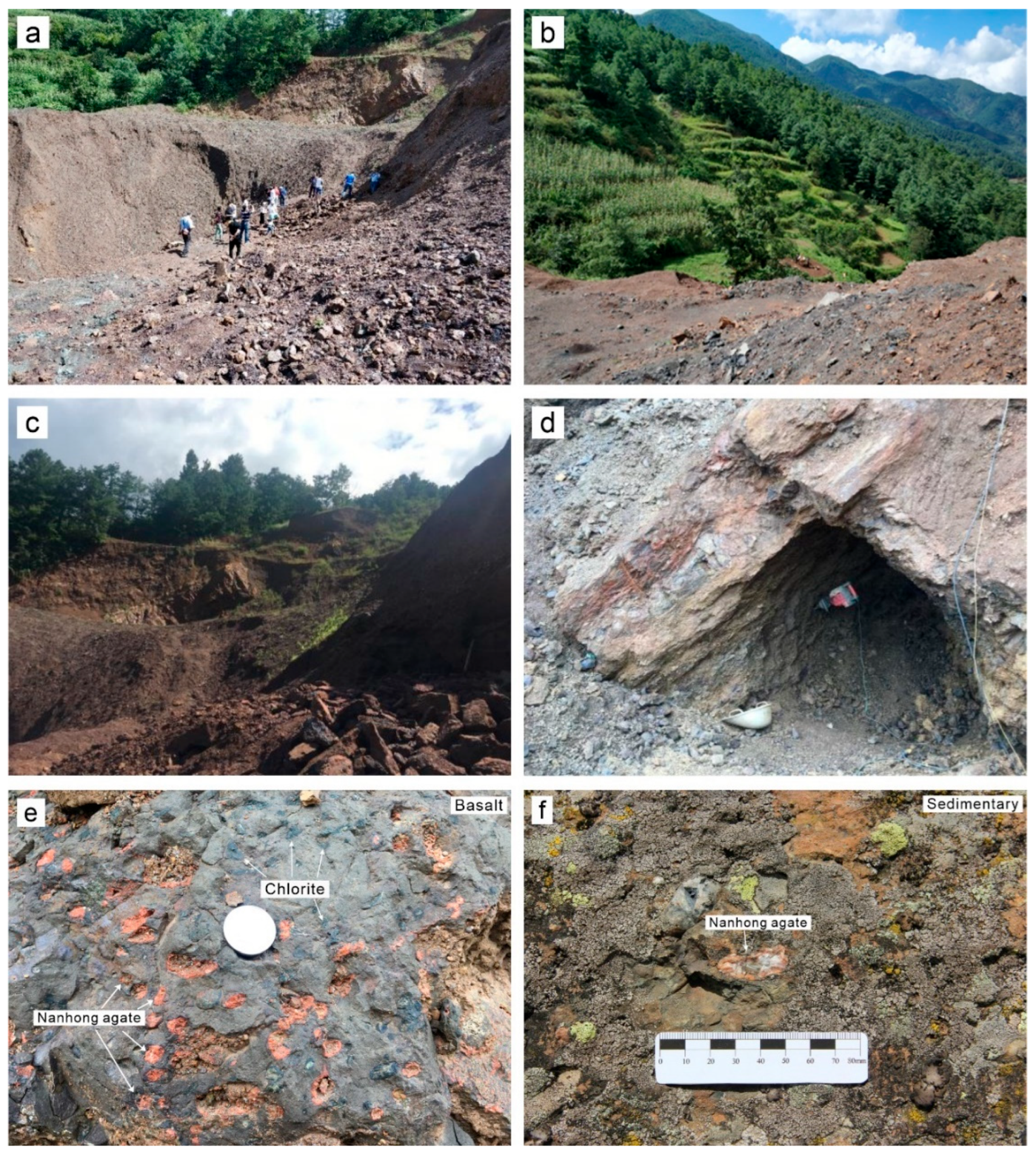
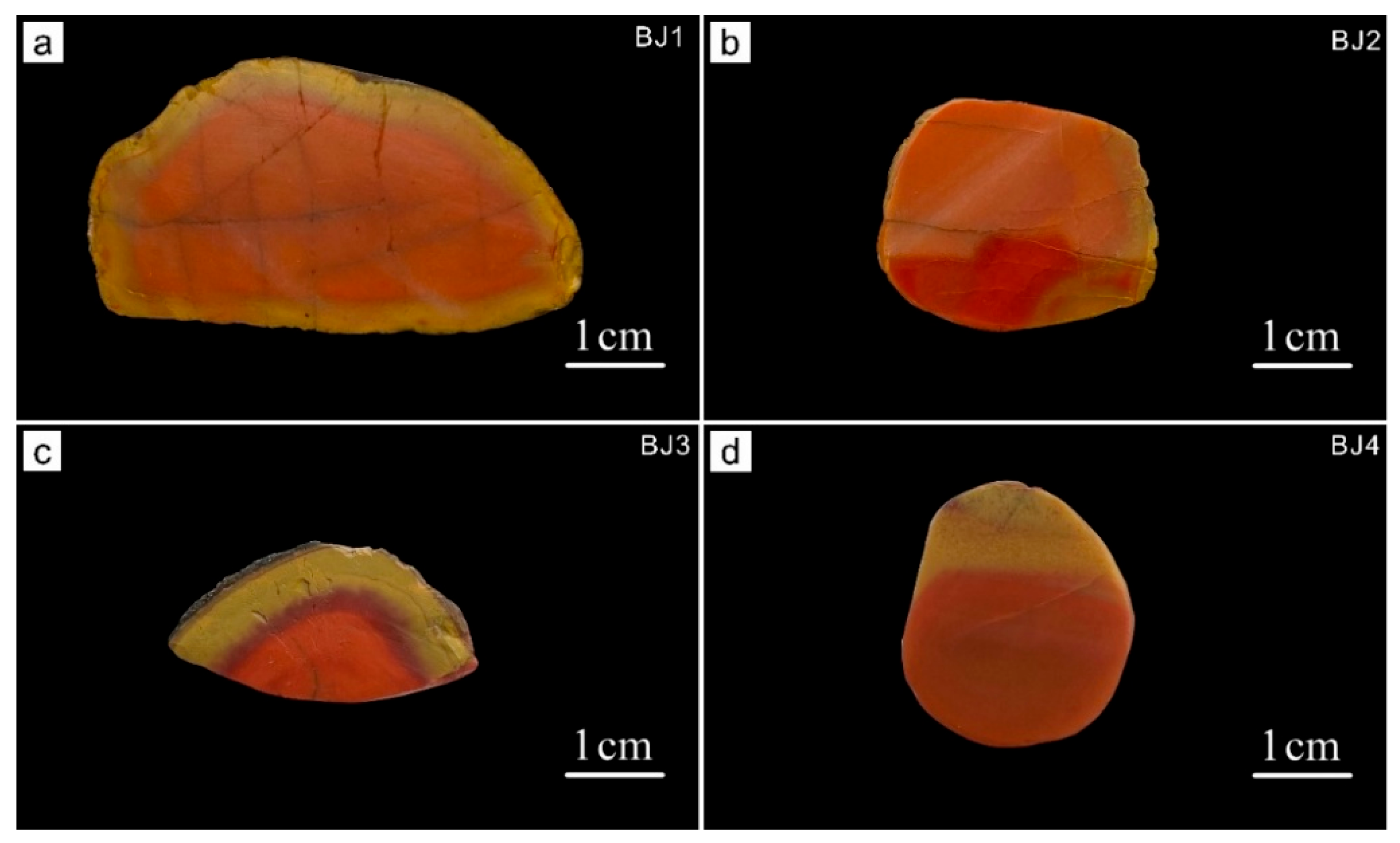
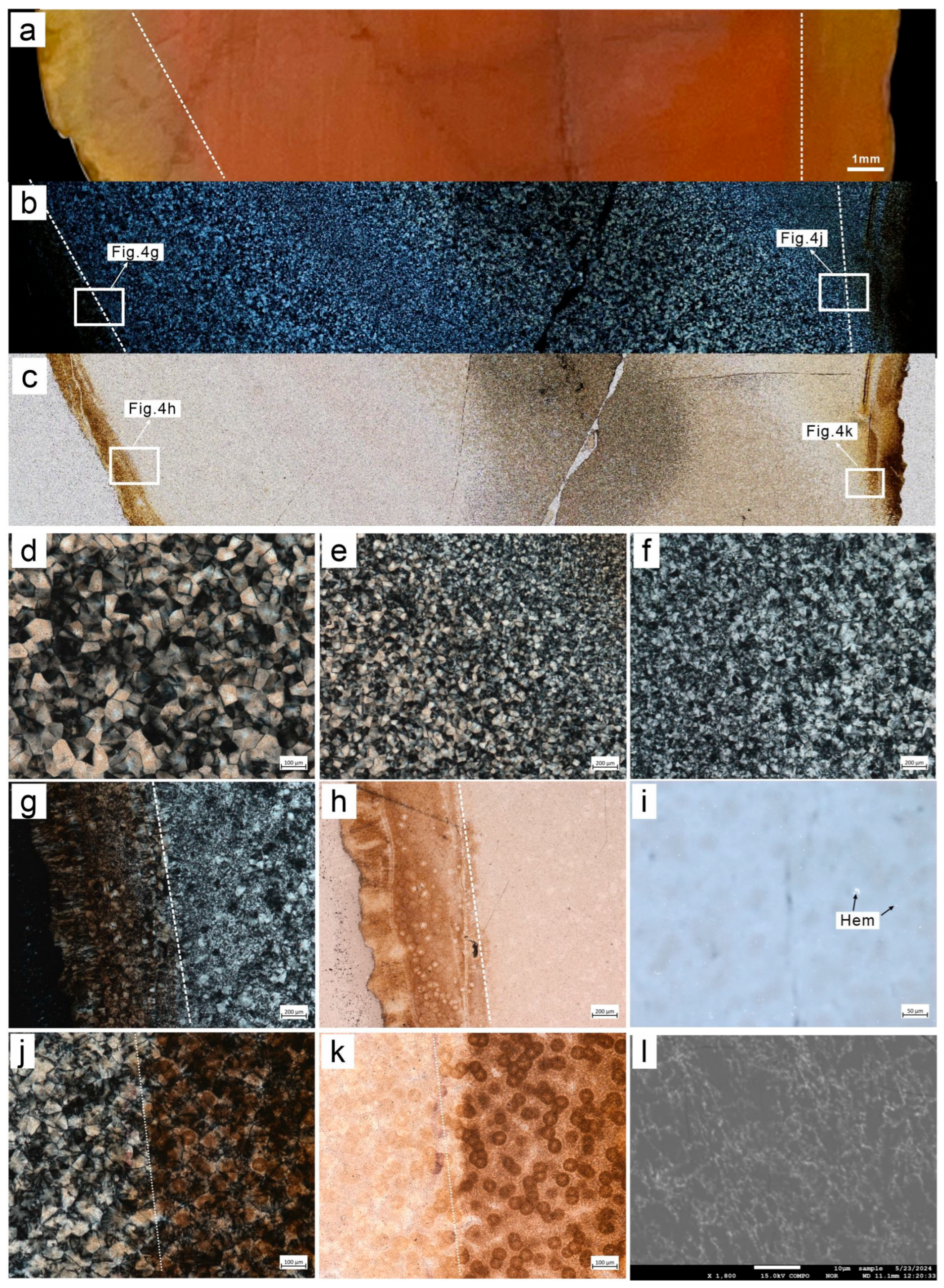
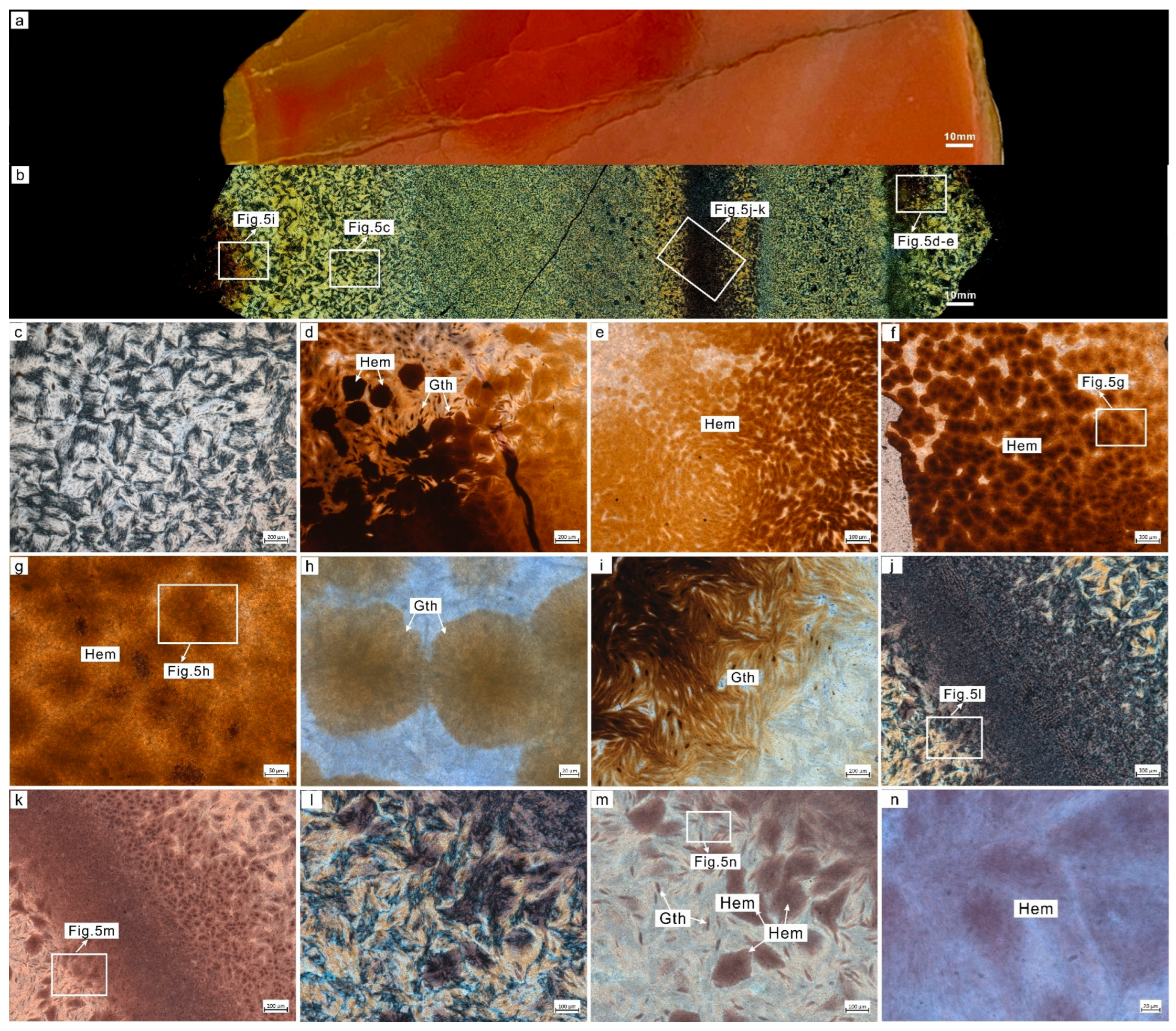


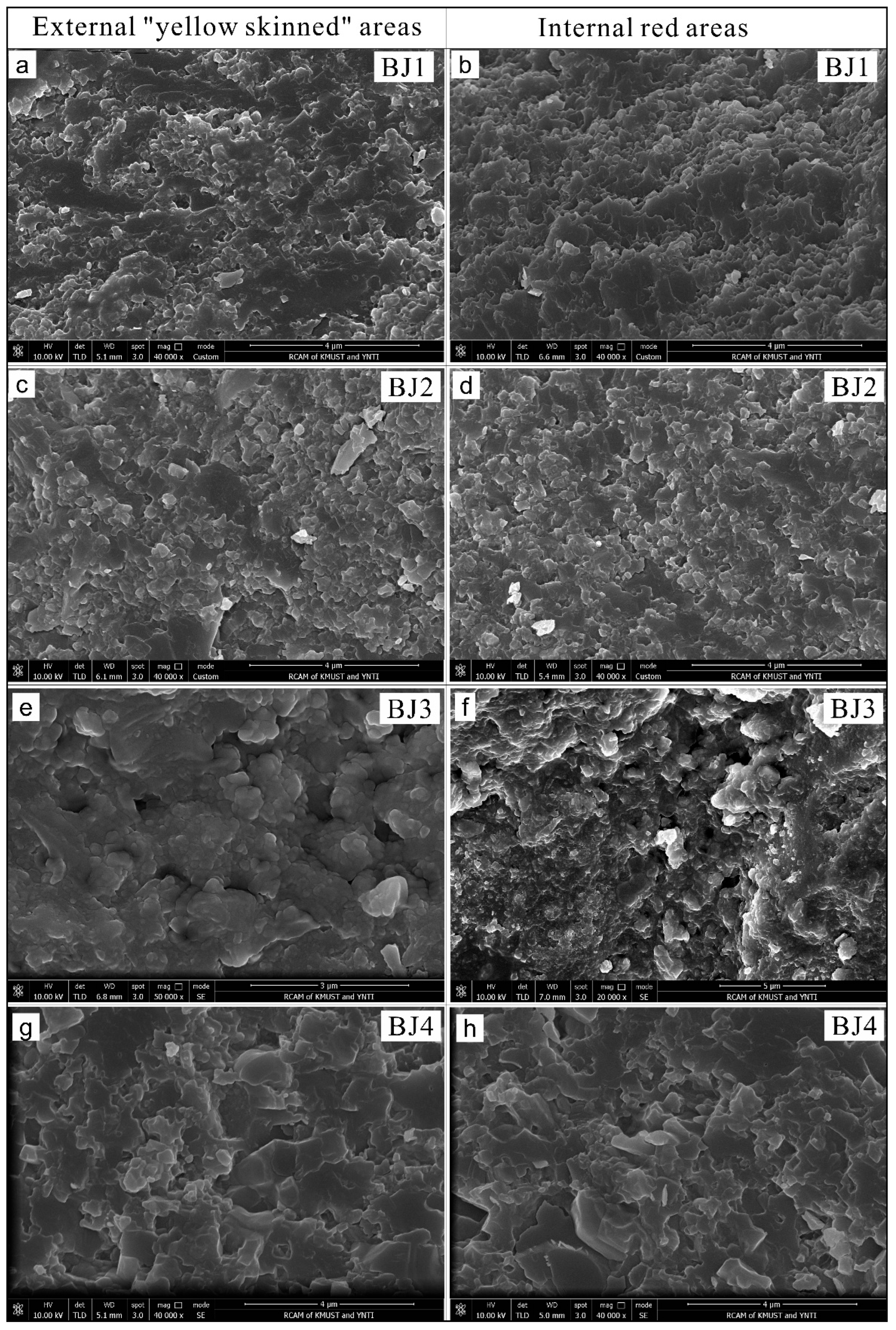

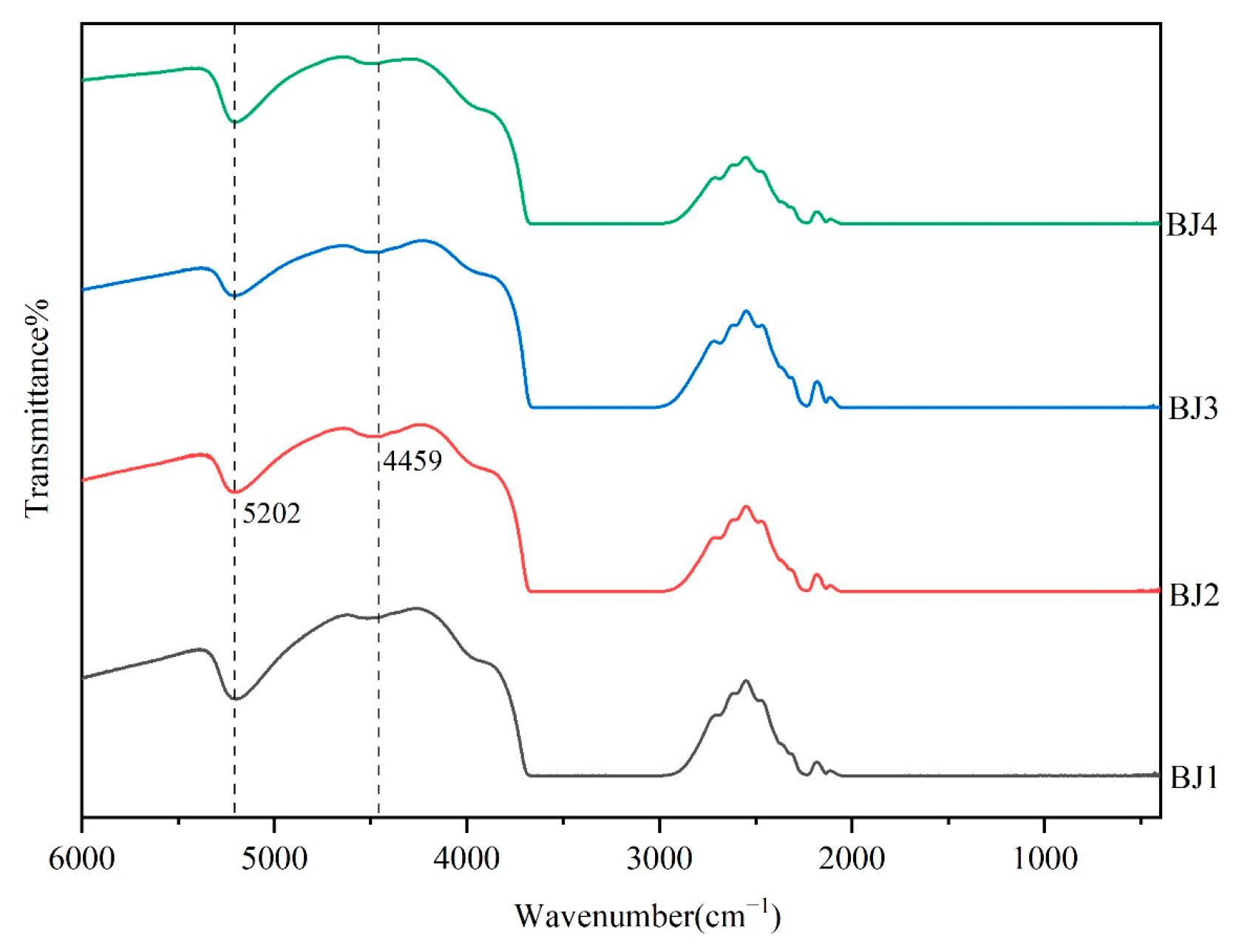
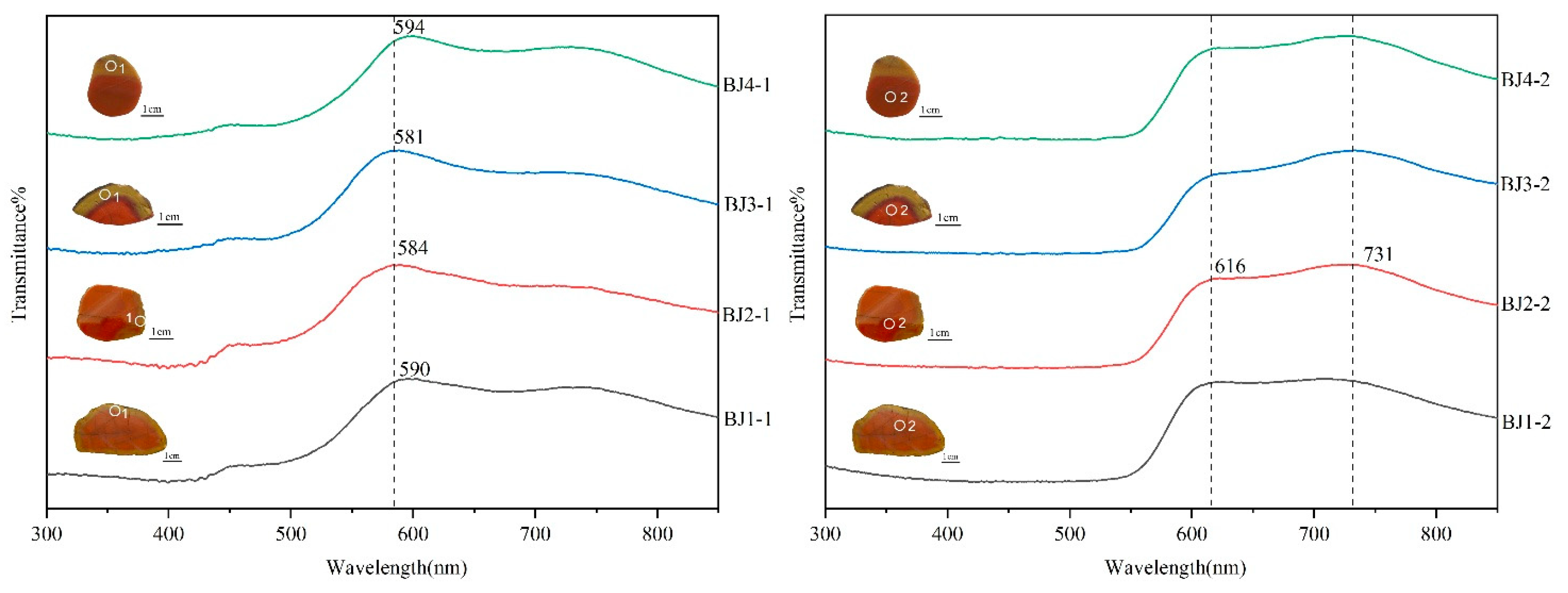
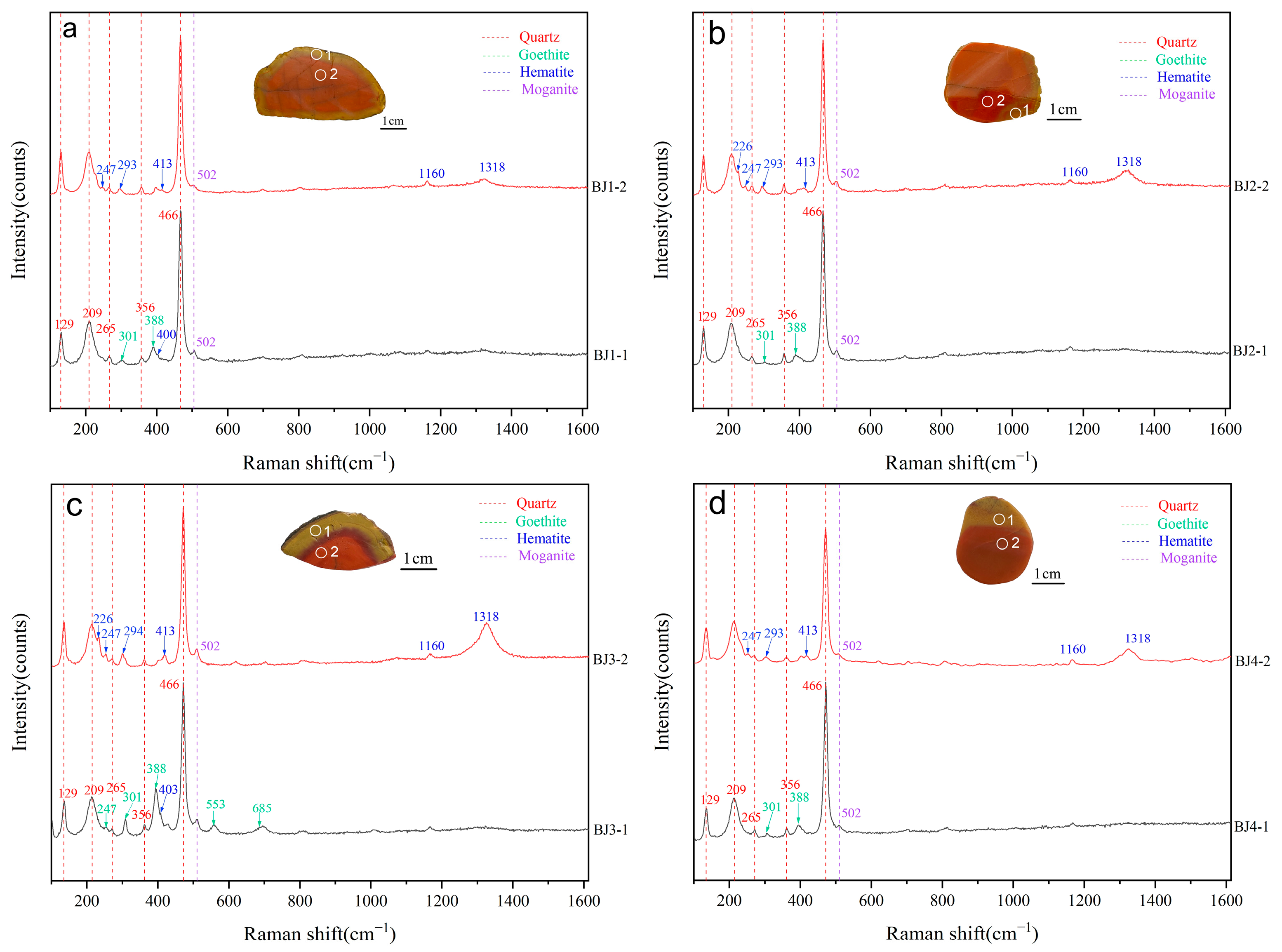
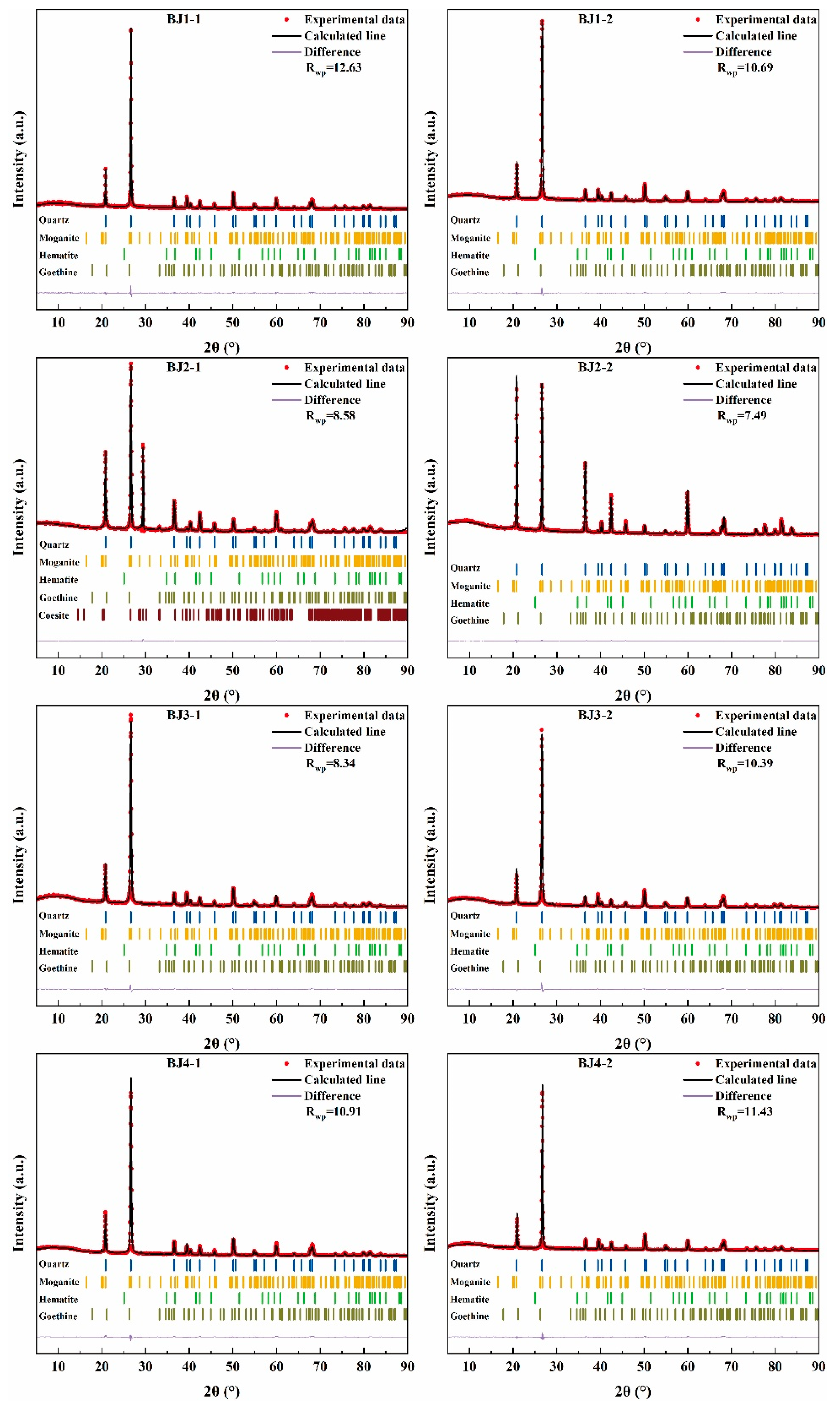
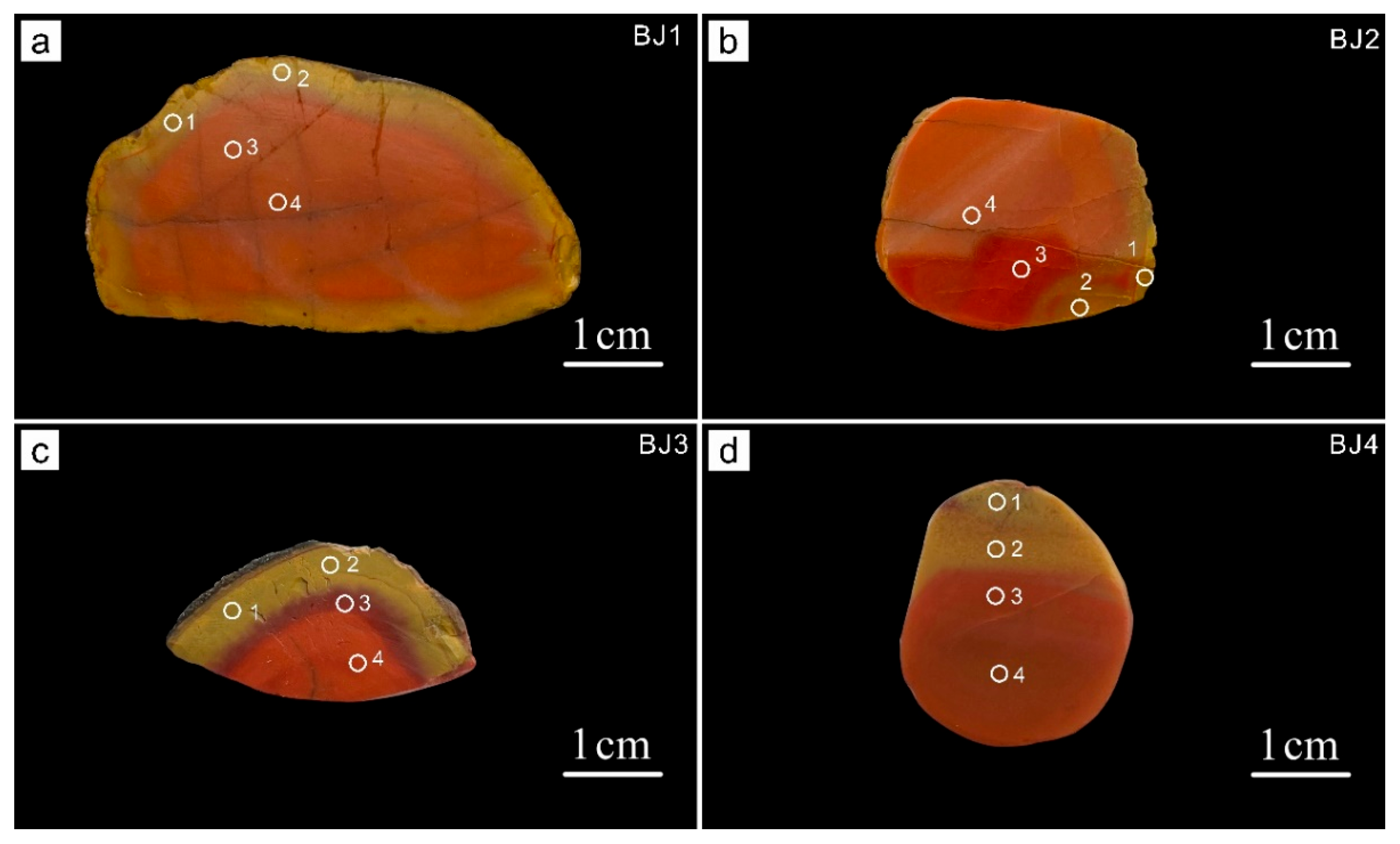
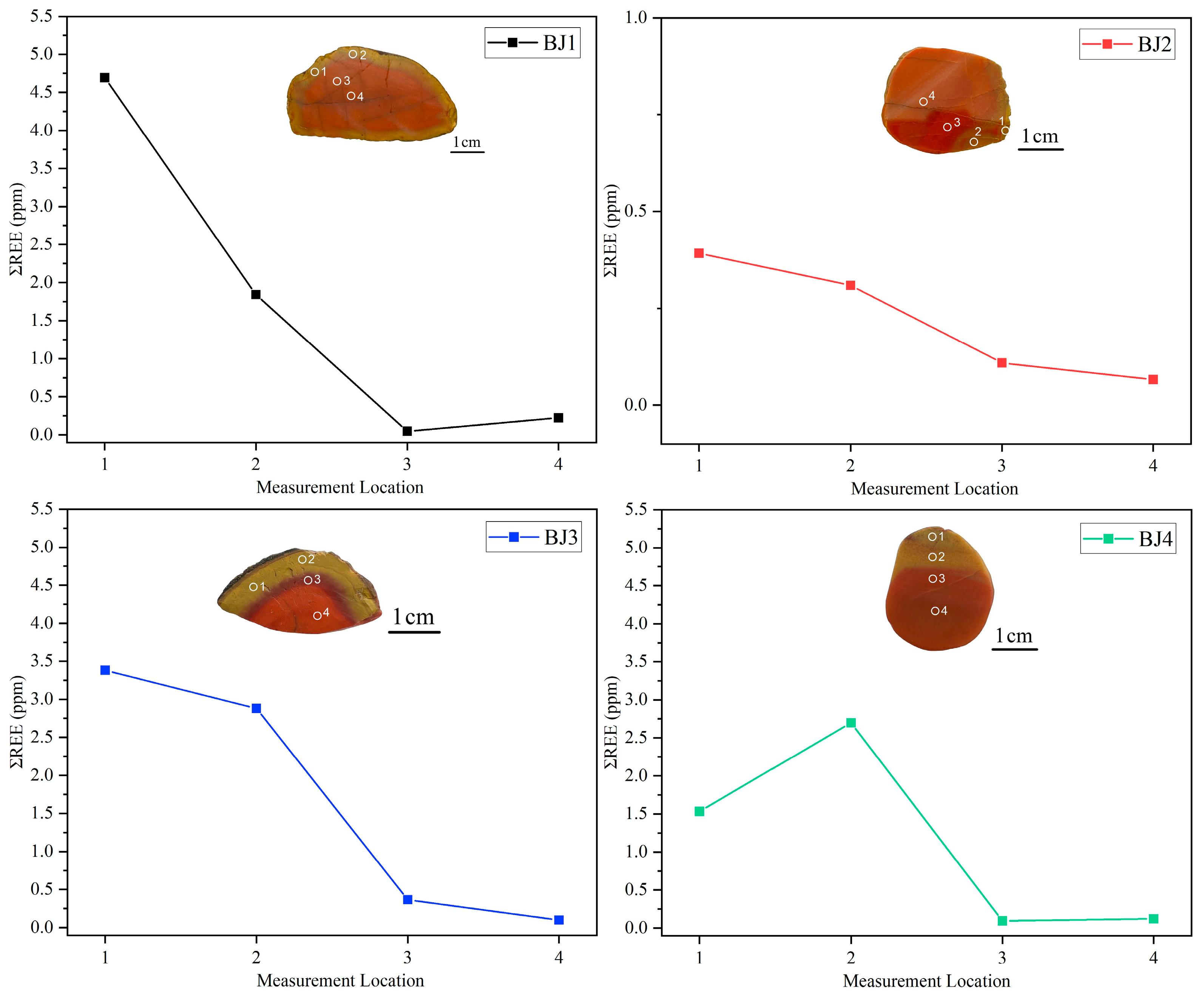
| No. | BJ1-1 | BJ1-2 | BJ2-1 | BJ2-2 | BJ3-1 | BJ3-2 | BJ4-1 | BJ4-2 |
|---|---|---|---|---|---|---|---|---|
| Quartz | 99.90 | 97.80 | 99.5 | 97.60 | 96.20 | 95.70 | 95.60 | 99.20 |
| Moganite | 0.00 | 2.10 | 0.3 | 0.70 | 3.40 | 4.30 | 3.40 | 0.70 |
| Hematite | 0.10 | 0.10 | 0.1 | 0.00 | 0.00 | 0.00 | 0.10 | 0.00 |
| Goethite | 0.00 | 0.00 | 0.2 | 1.70 | 0.50 | 0.00 | 0.90 | 0.10 |
| No. | SiO2 | TiO2 | Al2O3 | FeO | MnO | MgO | CaO | Na2O | K2O | P2O5 | UO2 | SO3 | Total |
|---|---|---|---|---|---|---|---|---|---|---|---|---|---|
| BJ1-1 | 94.57 | 0.00 | 0.17 | 4.62 | 0.02 | 0.02 | 0.09 | 0.02 | 0.03 | 0.08 | 0.00 | 0.01 | 99.63 |
| BJ1-2 | 96.59 | 0.00 | 0.14 | 2.75 | 0.00 | 0.00 | 0.08 | 0.02 | 0.01 | 0.03 | 0.04 | 0.00 | 99.66 |
| BJ1-3 | 99.44 | 0.01 | 0.09 | 0.07 | 0.01 | 0.01 | 0.00 | 0.02 | 0.02 | 0.02 | 0.00 | 0.01 | 99.70 |
| BJ1-4 | 99.28 | 0.02 | 0.06 | 0.03 | 0.00 | 0.00 | 0.00 | 0.00 | 0.00 | 0.00 | 0.11 | 0.00 | 99.52 |
| BJ2-1 | 93.47 | 0.01 | 0.09 | 4.69 | 0.00 | 0.03 | 0.03 | 0.03 | 0.00 | 0.05 | 0.00 | 0.00 | 98.41 |
| BJ2-2 | 95.21 | 0.00 | 0.06 | 2.79 | 0.01 | 0.01 | 0.07 | 0.02 | 0.02 | 0.06 | 0.00 | 0.00 | 98.25 |
| BJ2-3 | 99.30 | 0.00 | 0.03 | 0.04 | 0.03 | 0.00 | 0.00 | 0.02 | 0.00 | 0.00 | 0.03 | 0.00 | 99.45 |
| BJ2-4 | 99.46 | 0.02 | 0.01 | 0.08 | 0.03 | 0.00 | 0.00 | 0.00 | 0.01 | 0.00 | 0.01 | 0.00 | 99.62 |
| BJ3-1 | 99.37 | 0.00 | 0.00 | 0.27 | 0.02 | 0.00 | 0.04 | 0.00 | 0.00 | 0.03 | 0.00 | 0.02 | 99.79 |
| BJ3-2 | 96.67 | 0.00 | 0.12 | 1.47 | 0.00 | 0.00 | 0.03 | 0.00 | 0.02 | 0.05 | 0.00 | 0.00 | 98.40 |
| BJ3-3 | 99.11 | 0.00 | 0.00 | 0.03 | 0.00 | 0.03 | 0.01 | 0.00 | 0.02 | 0.00 | 0.00 | 0.00 | 99.24 |
| BJ3-4 | 98.49 | 0.01 | 0.01 | 0.35 | 0.00 | 0.00 | 0.02 | 0.01 | 0.00 | 0.00 | 0.00 | 0.00 | 98.89 |
| BJ4-1 | 92.60 | 0.00 | 0.12 | 5.00 | 0.04 | 0.02 | 0.09 | 0.03 | 0.02 | 0.14 | 0.00 | 0.01 | 98.07 |
| BJ4-2 | 97.61 | 0.00 | 0.13 | 0.55 | 0.00 | 0.00 | 0.02 | 0.00 | 0.03 | 0.00 | 0.04 | 0.00 | 98.37 |
| BJ4-3 | 98.39 | 0.03 | 0.06 | 0.10 | 0.00 | 0.00 | 0.04 | 0.02 | 0.01 | 0.00 | 0.03 | 0.00 | 98.69 |
| BJ4-4 | 99.18 | 0.02 | 0.03 | 0.09 | 0.02 | 0.01 | 0.00 | 0.00 | 0.02 | 0.07 | 0.00 | 0.00 | 99.44 |
Disclaimer/Publisher’s Note: The statements, opinions and data contained in all publications are solely those of the individual author(s) and contributor(s) and not of MDPI and/or the editor(s). MDPI and/or the editor(s) disclaim responsibility for any injury to people or property resulting from any ideas, methods, instructions or products referred to in the content. |
© 2025 by the authors. Licensee MDPI, Basel, Switzerland. This article is an open access article distributed under the terms and conditions of the Creative Commons Attribution (CC BY) license (https://creativecommons.org/licenses/by/4.0/).
Share and Cite
Song, Q.; Zhang, S.; Pu, W.; Chen, L.; Zuo, R.; Chen, X.; Zhang, D.; Liu, W. Formation Mechanism and Gemological Characteristics of “Yellow-Skinned” Nanhong Agate in Northeastern Yunnan, China: Evidence from Mineralogy and Geochemistry. Crystals 2025, 15, 488. https://doi.org/10.3390/cryst15050488
Song Q, Zhang S, Pu W, Chen L, Zuo R, Chen X, Zhang D, Liu W. Formation Mechanism and Gemological Characteristics of “Yellow-Skinned” Nanhong Agate in Northeastern Yunnan, China: Evidence from Mineralogy and Geochemistry. Crystals. 2025; 15(5):488. https://doi.org/10.3390/cryst15050488
Chicago/Turabian StyleSong, Qiuyun, Shitao Zhang, Wenzhou Pu, Liurunxuan Chen, Ruohan Zuo, Xianchao Chen, Dai Zhang, and Wenlian Liu. 2025. "Formation Mechanism and Gemological Characteristics of “Yellow-Skinned” Nanhong Agate in Northeastern Yunnan, China: Evidence from Mineralogy and Geochemistry" Crystals 15, no. 5: 488. https://doi.org/10.3390/cryst15050488
APA StyleSong, Q., Zhang, S., Pu, W., Chen, L., Zuo, R., Chen, X., Zhang, D., & Liu, W. (2025). Formation Mechanism and Gemological Characteristics of “Yellow-Skinned” Nanhong Agate in Northeastern Yunnan, China: Evidence from Mineralogy and Geochemistry. Crystals, 15(5), 488. https://doi.org/10.3390/cryst15050488






